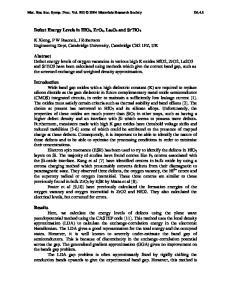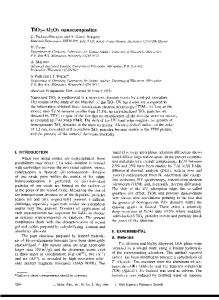Atomic layer deposition of HfO 2 , Al 2 O 3 , and HfAlO x using O 3 and metal(diethylamino) precursors
- PDF / 849,560 Bytes
- 10 Pages / 612 x 792 pts (letter) Page_size
- 81 Downloads / 398 Views
Ronald Inman, Gregory Jursich, and Axel Soulet American Air Liquide, Chicago Research Center, Countryside, Illinois 60525
Christos Takoudisa) Departments of Chemical Engineering and Bioengineering, University of Illinois at Chicago, Chicago, Illinois 60607 (Received 29 March 2007; accepted 4 September 2007)
Tetrakis-diethylamino hafnium (TDEAH), tris-diethylamino aluminum (TDEAA), and ozone were used for the atomic layer deposition (ALD) of HfO2, Al2O3, and HfAlOx films. The ALD rates were measured to be 1.1 Å/cycle for HfO2 and 1.3 Å/cycle for Al2O3. The ALD temperature windows were found to be between 200 and 325 °C for TDEAA, and between 200 and 275 °C for TDEAH. The overlap of these ALD windows between 200 and 275 °C is critical for ALD of the composite film, HfAlOx. In addition to the overlapping ALD temperature windows, the two metal precursors have similar thermal characteristics, as shown by TGA and differential scanning calorimetry. As-deposited films and films postannealed at 600 and 800 °C films were analyzed using Fourier transformed infrared (FTIR) spectroscopy, x-ray photoelectron spectroscopy, and x-ray diffraction (XRD) techniques. FTIR spectra revealed interfacial oxide growth during deposition of both HfO2 and Al2O3 whose thickness increased with annealing temperature. The FTIR data also indicated hydroxyl and nitrate groups in the films; these species were removed after annealing in Ar at a temperature of 艌600 °C. Both FTIR and XRD results indicated the crystallization of pure HfO2 after annealing at temperatures as low as 600 °C. On the other hand, pure Al2O3 remained amorphous after annealing at temperatures up to 800 °C. XRD data of the composite HfAlOx film show that films deposited by alternating five cycles of HfO2 and one cycle of Al2O3 remained amorphous after annealing at 600 °C. Rutherford backscattering analysis of HfAlOx deposited with a varied number of alternating HfO2 and Al2O3 cycles demonstrated a strong correlation between the cyclic dosage of TDEAA and TDEAH and the film composition. I. INTRODUCTION
Ultrathin, high-dielectric constant () films that can maintain discrete interfaces and amorphous structure during high-temperature fabrication processes are critical to the future minimization of microelectronic devices. In particular, there is considerable need to identify replacement dielectric films for the gate oxide insulator in complementary metal-oxide semiconductor transistors and the capacitive charge storage in dynamic randomaccess memory (DRAM) cells.1,2 To maintain thickness control at the needed dimensions (in nanometers) within the gate oxide and to proa)
Address all correspondence to this author. e-mail: [email protected] DOI: 10.1557/JMR.2007.0439 J. Mater. Res., Vol. 22, No. 12, Dec 2007
http://journals.cambridge.org
Downloaded: 09 Jul 2014
vide sufficient conformal coverage down the deep trenches of DRAM devices, atomic layer deposition (ALD) has been identified as the preferred technique over other techniques like e-beam deposition, physical vapor depositio











